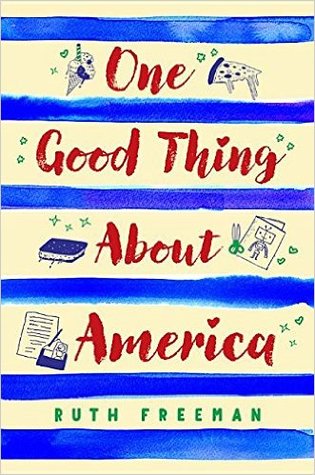One Good Thing About America
by Ruth Freeman
illustrated by Kathrin Honesta
Holiday House, March 2017
review ARC received at ALA Midwinter
Ruth Freeman works in the ELL department of an elementary school in South Portland, Maine. She acknowledges in the author's notes that hers is an outsider's perspective of what it's like to be a refugee or asylum seeker. Until this generation of refugee children grows up to write their own stories, the best we've got are stories from some of the people who know them best -- their teachers.
Anaïs is a refuge of Congo. Her grandmother, father and brother are still there. Her father and brother are on the run from the government. It is her grandmother to whom she writes, and her grandmother who encourages her to tell "one good thing about America" in every letter. Sometimes that's hard for Anaïs because, though she was top in her class in English when she left Africa, there is so much about American English and American culture that baffles and frustrates her. Her voice is very authentic, starting with broken English and readable misspellings mixed liberally with French words, and smoothing out throughout the course of the book and her ten months of learning. In the back of the book, there is a list of words and phrases that are Anaïs is hearing (such as a silum and playd) paired with "the spelling she will learn" (asylum and played). Such wonderful respect for our English Language Learners!
Messages from Maryam
by Lauren Pichon
illustrated by Kendra Yoder
lulu.com, January 2017
review copy provided by the author
Like Freeman, Lauren Pichon is an ELL teacher. Her self-published picture book is also a story told in letters.
Aila and Maryam are Iraqi girls from Mosul. When Maryam and her family immigrate to the United States, she and Aila exchange letters throughout the long process of waiting in a refugee camp, flying to New York, driving to Virginia, starting school with no English, and adjusting to life in a new country. Eventually Aila's family makes it to Virginia as well and the girls are reunited.
In the author's notes, Pichon acknowledges that the exchange of letters from a refugee camp is fiction -- people in refugee camps cannot send or receive mail. As with One Good Thing About America, the letter format is, nonetheless, an effective way to let the reader experience the loneliness, isolation, and frustration of the refugee experience. The contrast between Maryam's new life in America and the description of her life in Mosel and her and Aila's time in refugee camps will give American readers a better sense of what their new classmates have gone through.


No comments:
Post a Comment
Comment moderation is turned on.